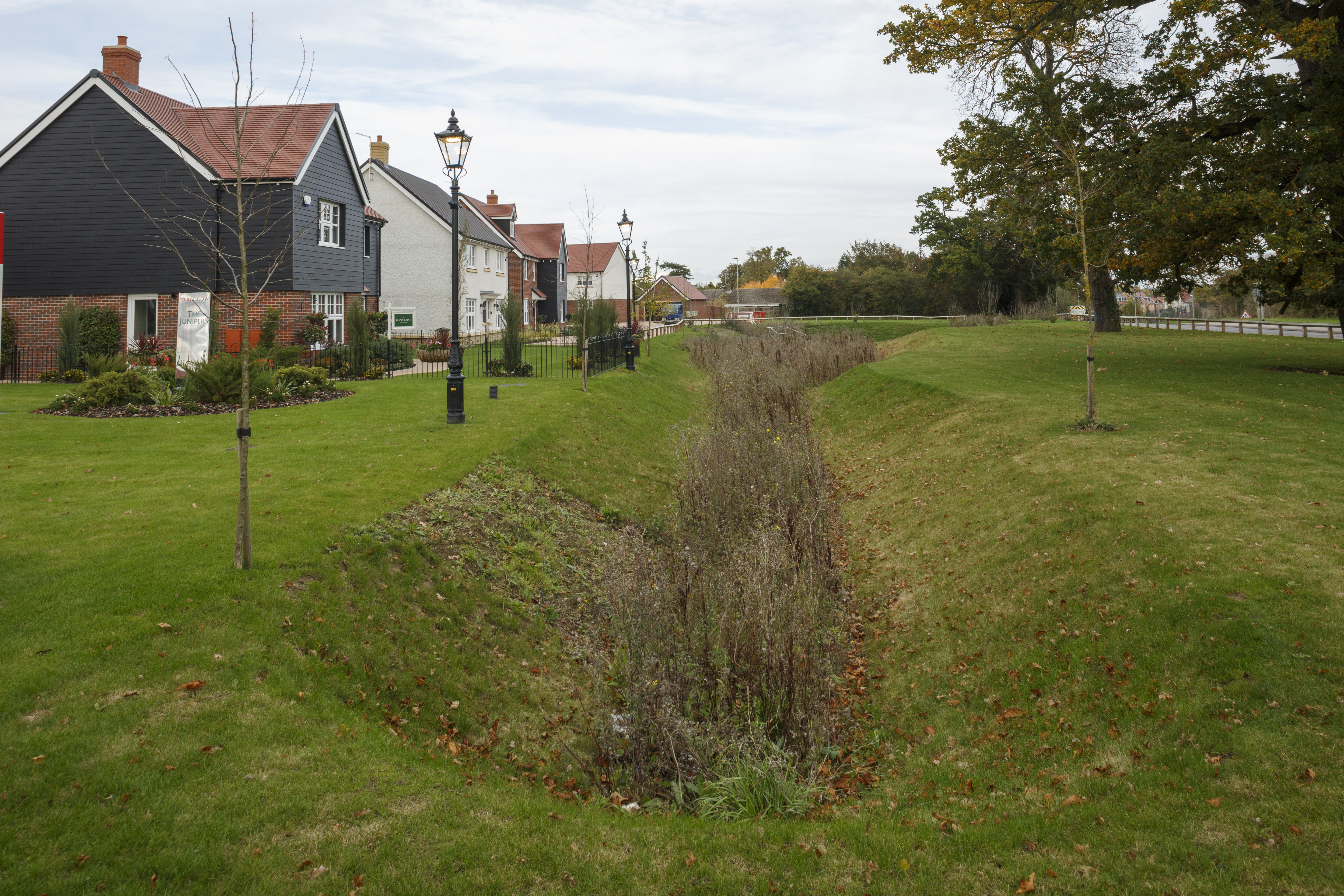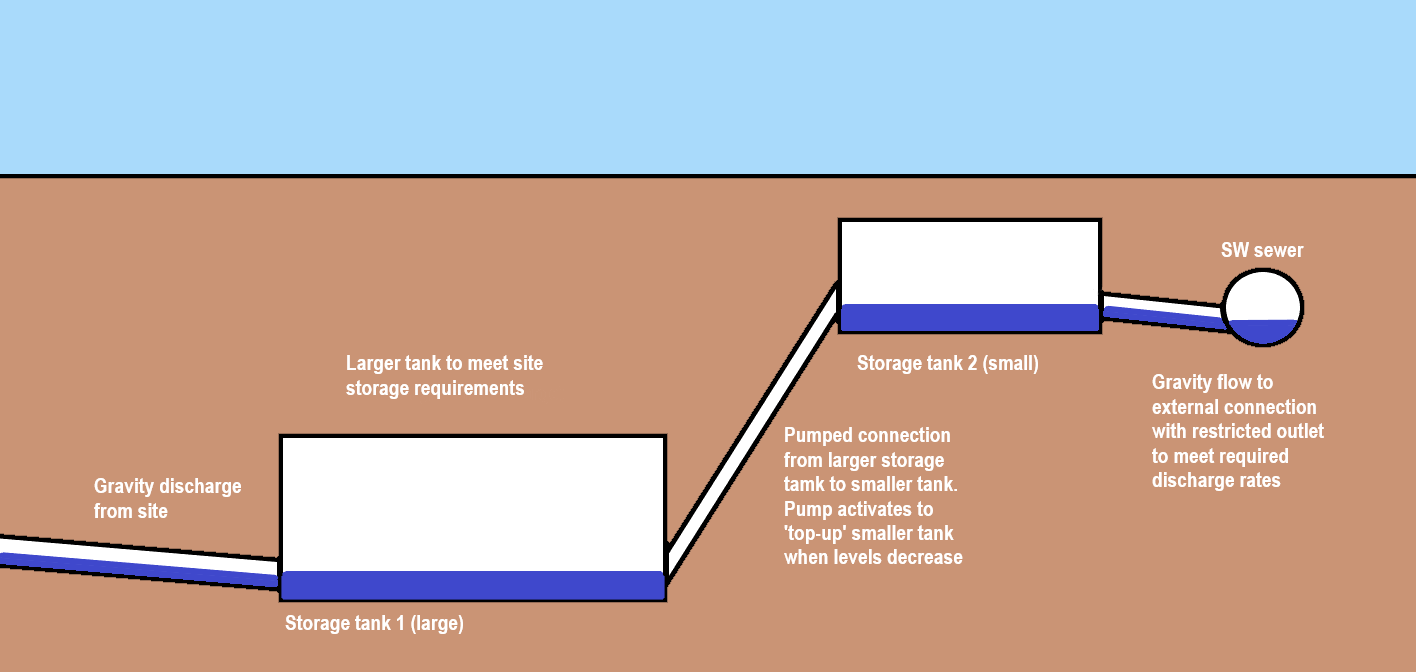Greenfield Runoff Rates
| What the LLFA expect to see For all applications where infiltration is not viable the LLFA expect to see that the discharge rates are being restricted to 1 in 1-year greenfield runoff rate (or matched rates). It is expected that if this is not the case then evidence is provided to show why. The greenfield runoff rates provided should be accompanied by their calculations in order to understand if it has been calculated with the correct inputs. It should also be shown that the discharge location is in line with the drainage hierarchy and that the necessary permissions have been granted. |
SuDS networks should be designed to mimic natural drainage routes. When discharging to a watercourse it should be proven that the final discharge location is the same as where it currently drains otherwise runoff is being increased elsewhere due to the development. In addition, where the pre-development site has multiple discharge locations, a catchment-based approach should be utilised in order to not increase runoff.
Surface water runoff can be discharged in three ways:
1. Restricting to the 1 in 1-year greenfield rate
The LLFA preference is that runoff must not increase due to the development and all runoff should be first restricted to the greenfield 1 in 1-year runoff rate during all events up to and including the 1 in 100-year rainfall event with climate change.
2. Restricting to flow matching rates
Alternatively, if restricting to the 1 in 1-year greenfield rate approach is not possible discharge rates can be limited to a range of equivalent greenfield discharge rates. For example, the 1 in 1-year storm event will be limited to the 1 in 1-year greenfield run off rate, the 1 in 30-year storm event will be limited to the 1 in 30-year storm event and the 1 in 100-year rate will be limited to the 1 in 100-year storm event (inclusive of a climate change allowance). If this alternative approach is used, then there should also be an inclusion of long-term storage. It is however the LLFA’s preference that a single rate discharge is used unless it is proven that a flow matching scheme is the more conservative approach.
3. Discharging to a tidal estuary
In instances where the final discharge location is to a tidal estuary then it is accepted that discharge rates are unrestricted. However, evidence should be provided to ensure that the surface water will be managed during a tide locking scenario. This should be demonstrated by showing that the surface water can be managed for a 1 in 100-year pluvial storm event plus climate change and a 1 in 20 year fluvial/tidal storm event coinciding. Likewise, when discharging to a main river, consideration should be given to a 1 in 20-year fluvial event coinciding with a 1 in 100-year pluvial event plus climate change at the development site.
Why the LLFA doesn’t accept QBar
The LLFA do not accept discharge rates being limited to QBAR (mean annual maximum flow rate). The QBAR estimation procedure is based on higher return periods (>2), and results in higher estimated values for final discharge from the site than 1 in 1 Greenfield runoff rates. There are significant differences in storage volumes and final discharge rates when considering QBAR as an allowable discharge from the site. Further it could have potential increase in risk of surface water flooding due to increased discharge rates that opposed natural greenfield runoff. Therefore, the LLFA require discharge rates to be limited to 1 in 1 Greenfield rates.
The risk of blockages
Historically, minimum discharge rates have been limited to 5l/s due to the risk of blockage of outlets with an orifice size of smaller than 50mm. However, through the use of appropriate design such as checked dams, trash screens, and sufficient upstream treatment orifice sizes can be made larger with discharge rates being limited far below 5l/s without causing an unacceptable risk of blockage. Other features such as permeable paving, and vortex flow control devices are also proficient in reducing the risk of blockages. The LLFA require that runoff rates are limited to 1l/s or the 1 in 1-year greenfield rate, whichever is higher, unless discharge is via permeable paving which is further able to reduce the risk of blockage. If all surface water first goes through features like permeable/porous paving then the majority of pollution and debris will be prevented from reaching the outfall, therefore discharge rates will be able to be lower than 1l/s. An exception for this is when discharging to an Anglian Water surface water sewer, the minimum final outlet size that they will accept is 75mm. Therefore, if discharging to an Anglian Water surface water sewer the discharge rate should be as close to the greenfield 1 in 1 year run off rate as possible with a minimum final outlet size limit of 75mm. Additionally to minimise the risk of blockage, the LLFA expect materials that may cause blockages to be removed from the system as high up the system as possible.
Where it is not possible to limit rates back to the 1 in 1-year greenfield rate because this may cause blockages, additional consideration should be given to rainwater and stormwater re-use to minimise the impact of smaller storm events. This consideration can be in the form of the average figures for the specific feature, showing how much water it can hold and how much of this water on average is used, highlighting its average capacity. This can therefore be used towards the storage totals. This however does not include water buts as these have to be emptied manually and therefore have an unreliable storage volume.
Discharging to a surface water sewer
When discharging to a surface water sewer, permission in principle or in full (depending on what stage in the application process it is) should be demonstrated to show that there is a viable outfall from the site. Where this is the case the LLFA still expect the 1 in 1-year greenfield runoff rate or flow matching discharge limit to be met. If this is unviable due to the service providers requiring minimum orifice sizes (such as Anglian Water) then the lowest rate possible will be accepted in line with this, as long as evidence is provided to support its use. It should also be noted that discharge rates should not be limited to the maximum capacity as given by the provider.
It is recommended that if you intend for the drainage of your site to be adopted by a third party that they are engaged early on in the design process to ensure that features meet the adoptable standards.
Discharge Via Pump
New sites should consider gravity outfalls wherever possible. If this is deemed to not be possible, then a pumped solution can be used.
Pumping systems are only triggered when the pump chamber is filled with the required water level. In this instance, during intense storms, the pump continuously operates and will discharge at higher rates than the average/restricted discharge rates. This will have significant impacts on surface water flooding downstream. The LLFA recommends that the more conservative approach is always used to limit discharge rates from the development when using pumping system.
Pump discharge to meet greenfield rates
For sites where surface water discharges cannot be achieved through gravity and a pumping system is used, the required discharge rates must still be met to ensure compliance with DEFRA’s non-statutory technical standard for sustainable drainage system and the Essex SuDS Design Guide greenfield runoff rates criteria. This can be achieved in various ways, but it is recommended that a system involving a secondary, smaller storage tank with a restricted outlet be installed between the main site storage and the external discharge point (as shown in the below figure). In such a system, the smaller tank is ‘topped-up’ from the main storage by the pump when the level drops, ensuring that there is constant flow whilst both meeting the required discharge rates and achieving the necessary storage.
Sites using a pumping system should demonstrate the risk associated with pump failure/blockage. This includes:
- How surface water will be routed through the site in an event of blockage or failure of the pump.
- Downstream flood risk management in an event greater than the 1 in 100 plus climate change storm event.
- Onsite exceedance flows and risk of surface water flooding (flow routes should be directed away from porosities).
The LLFA recommends where possible the use of pump discharge should be kept to a minimum and consideration should be given to the implications associated with the maintenance of pumping.
Page updated: 19/03/2021

